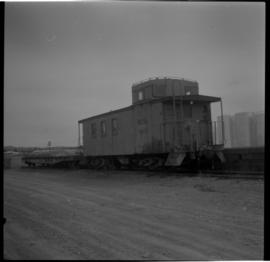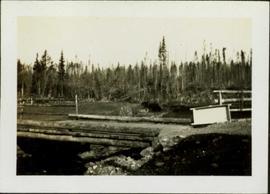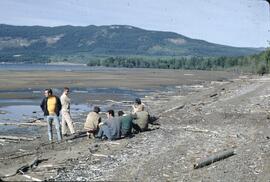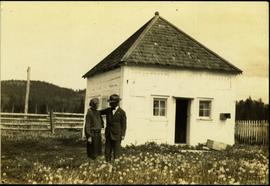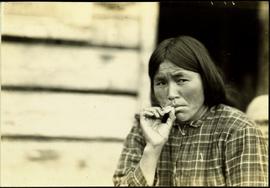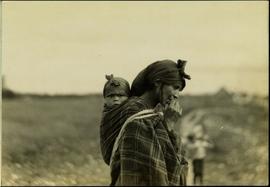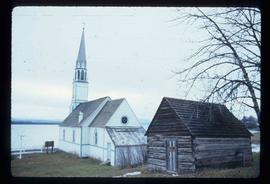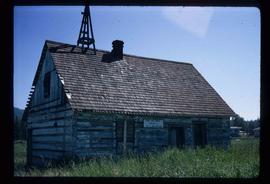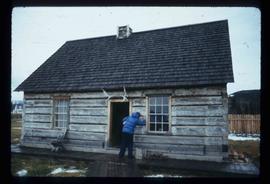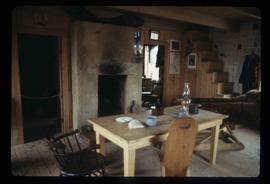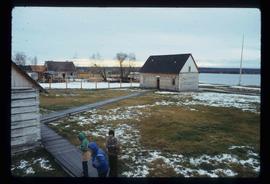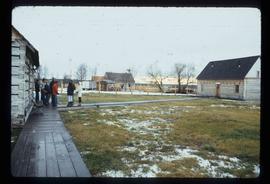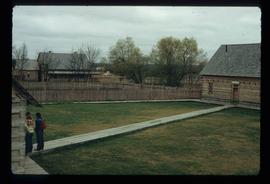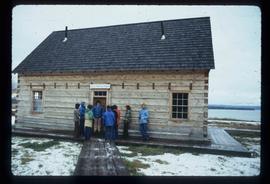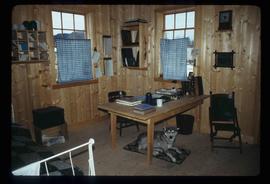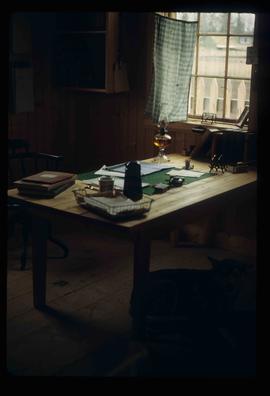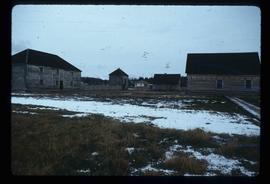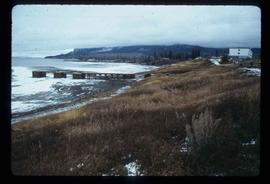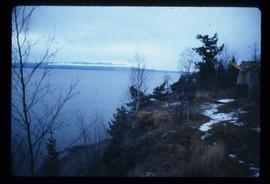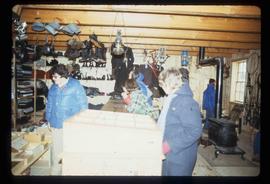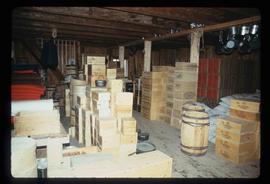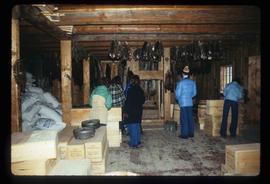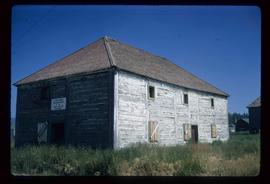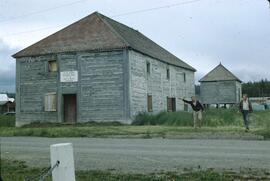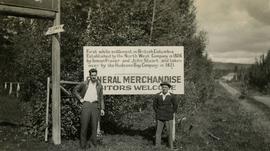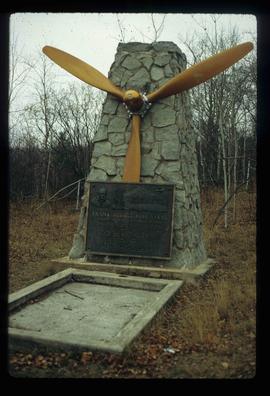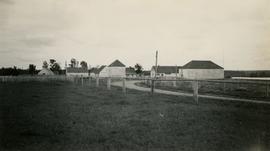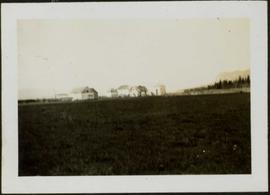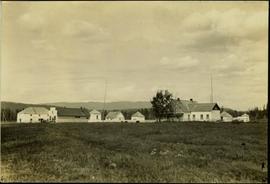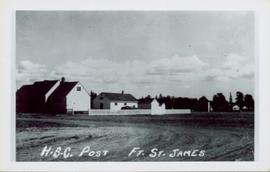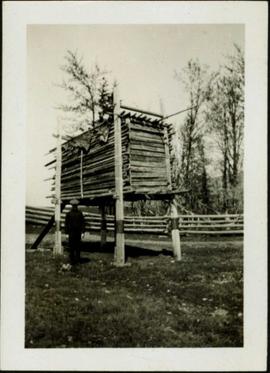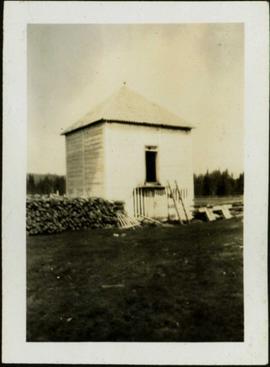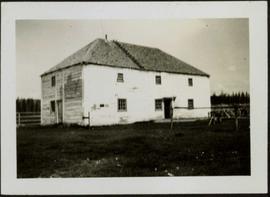Photograph depicts a caboose and a flat car that was built in 1956.
Photograph depicts a switcher and a way freight locomotive that was stationed in Fort St. James. The passenger train ran from Driftwood to Fort St. James.
Photograph depicts a short wooden bridge spanning Dog Creek mid-ground and a stand of trees in the background. There are many Dog Creeks within British Columbia, it is believed this Dog Creek is located just south of Fort St. James, BC. Handwritten photo caption below photograph reads: "Dog Creek".
Image depicts a cemetery at an uncertain location, possibly in Fort St. James, B.C.
Image depicts the interior of a church, likely in Fort St. James, B.C.
Summary of the diary of Willard Freer, April 1, 1946 to September 30, 1947:
- March 27-April 15, 1946: Fort St. James, working with Hendry Kinniburgh
- April 15-May 3, 1946: Took the Greyhound bus from Prince George to southern BC to visit family (Keremeos, Penticton, Cawston)
- May 3-5, 1946: Travelled with family to Wenatchee, Washington to see a flower show
- May 6-11, 1946: Returned with family to Cawston, BC
- May 12-14, 1946: Return trip north to Fort St. James on the Greyhound bus via Keremeos, Ashcroft, Quesnel, and Prince George
- May 15-28, 1946: Preparing for summer work in Fort St. James
- May 28-September 4, 1946: Departed from Fort St. James for employment with Emil Bronlund and the Consolidated Mining and Smelting Co., packing through the Omineca District up to Thutade Lake
- September 9-October 25, 1946: Return trip to Diamond J Ranch
- October 26, 1946-May 27, 1947: Diamond J Ranch
- May 27-June 17, 1947: Travel to the British Columbia-Yukon Boundary Survey and preparations for work
- June 18-October 11, 1947: Head packer for the British Columbia-Yukon Boundary Survey
Summary of the diary transcript of Willard Freer, April 1, 1946 to September 30, 1947:
- March 27-April 15, 1946: Fort St. James, working with Hendry Kinniburgh
- April 15-May 3, 1946: Took the Greyhound bus from Prince George to southern BC to visit family (Keremeos, Penticton, Cawston)
- May 3-5, 1946: Travelled with family to Wenatchee, Washington to see a flower show
- May 6-11, 1946: Returned with family to Cawston, BC
- May 12-14, 1946: Return trip north to Fort St. James on the Greyhound bus via Keremeos, Ashcroft, Quesnel, and Prince George
- May 15-28, 1946: Preparing for summer work in Fort St. James
- May 28-September 4, 1946: Departed from Fort St. James for employment with Emil Bronlund and the Consolidated Mining and Smelting Co., packing through the Omineca District up to Thutade Lake
- September 9-October 25, 1946: Return trip to Diamond J Ranch
- October 26, 1946-May 27, 1947: Diamond J Ranch
- May 27-June 17, 1947: Travel to the British Columbia-Yukon Boundary Survey and preparations for work
- June 18-October 11, 1947: Head packer for the British Columbia-Yukon Boundary Survey
Summary of the diary of Willard Freer, July 1, 1945 to March 31, 1946:
- June 3-7, 1945: Trip to Thutade Lake as a packer for Emil Bronlund, mining engineer for Consolidated Mining and Smelting
- June 7-October 5, 1945: Thutade Lake
- October 5-12, 1945: Trip to Fort Ware
- October 14-26, 1945: Return trip to Diamond J Ranch
- October 27-December 31, 1945: Diamond J Ranch
- January 1-February 25, 1946: Diamond J Ranch
- February 25-March 3, 1946: Trip to Fort Ware
- March 3-13, 1946: Fort Ware
- March 13-26, 1946: Fort Ware to Fort St. James
- March 27-April 15, 1946: Fort St. James, working with Hendry Kinniburgh
Summary of the diary of Willard Freer, July 1, 1945 to March 31, 1946:
- June 3-7, 1945: Trip to Thutade Lake as a packer for Emil Bronlund, mining engineer for Consolidated Mining and Smelting
- June 7-October 5, 1945: Thutade Lake
- October 5-12, 1945: Trip to Fort Ware
- October 14-26, 1945: Return trip to Diamond J Ranch
- October 27-December 31, 1945: Diamond J Ranch
- January 1-February 25, 1946: Diamond J Ranch
- February 25-March 3, 1946: Trip to Fort Ware
- March 3-13, 1946: Fort Ware
- March 13-26, 1946: Fort Ware to Fort St. James
- March 27-April 15, 1946: Fort St. James, working with Hendry Kinniburgh
Typed annotation on recto: "The Factor's Home H.B.Co. Post Fort St. James, Stuart Lake, B.C." Man and woman stand formally attired in front of small, square, white house. Log fence and tree-covered hillside in background.
Typed annotation on recto: "Indian Girl at Fort St. James Stuart Lake, B.C." Young woman smoking in front of unidentified building.
Typed annotation on recto: "Indian papoose at Fort St. James Stuart Lake, B.C." Child, wrapped in plaid blanket, being carried on back of woman in a field, other people in background.
Image depicts a church in Fort St. James, B.C.
Image depicts an old log building in Fort St. James; the sign on it reads "Clerk's Living Quarters, Later Used as Fort St. James First School."
Image depicts a historic building in Fort St. James, B.C.
Image depicts the interior of a historic building in Fort St. James, B.C.
Image depicts the Hudson's Bay Company historic site in Fort St. James, B.C.
Image depicts the Hudson's Bay Company historic site in Fort St. James, B.C.
Image depicts the Hudson's Bay Company historic site in Fort St. James, B.C.
Image depicts the Hudson's Bay Company historic site in Fort St. James, B.C.
Image depicts the historic Hudson's Bay Company office in Fort St. James, B.C.
Image depicts the interior of the historic Hudson's Bay Company office in Fort St. James, B.C.
Image depicts the interior of the historic Hudson's Bay Company office in Fort St. James, B.C.
Image depicts the Hudson's Bay Company Trading Post at the historic site in Fort St. James, B.C.
Image depicts an old shack on stilts in Fort St. James, B.C.
Image depicts Stuart Lake in Fort St. James, B.C.
Image depicts a partially frozen lake, most likely Stuart Lake in Fort St. James, B.C.
Image depicts a lake, possibly Stuart Lake in Fort St. James, B.C.
Image depicts the interior of the historic Hudson's Bay Company Trading Post, with several unknown individuals present, in Fort St. James, B.C.
Image depicts the interior of the historic Hudson's Bay Company Trading Post, with several unknown individuals present, in Fort St. James, B.C.
Image depicts the interior of the historic Hudson's Bay Company Trading Post in Fort St. James, B.C.
Image depicts the interior of the historic Hudson's Bay Company Trading Post, with several unknown individuals present, in Fort St. James, B.C.
Image depicts the old Trading Outpost in Fort St. James, B.C.
Item is a brochure promoting the 150th anniversary of Fort St. James, BC. The brochure contains a history of Fort St. James.
File consists of photographs depicting Fort St. James.
Photographs within this file document natural and artificial features across the landscape of Northern British Columbia. This landscape also includes the physical, built, urban and industrial landscapes; topography; site plans; boundaries, districts, reserves, parks, sanctuaries, towns, villages and cities, etc.
Photograph depicts (from left to right) Gordon Wyness and Jack Lee in front of the Fort St. James sign, which reads "First white settlement in British Columbia. Established by the North West Company in 1806 by Simon Fraser and John Stuart and taken over by the Hudson's Bay Company in 1821. - General Merchandise Visitors Welcome".
Image depicts the grave of Frank Russell "Russ" Baker in Fort St. James, B.C.
Photograph depicts the Hudson Bay buildings at Fort St. James.
Photograph depicts a group of buildings in distance behind fenced area. Field spans foreground and stand of trees in background. Handwritten photo caption below photograph reads: "H.B.C. Fort St. James ."
Typed annotation on recto: "Fort St. James H.B.Co. Post Stuart Lake, B.C." Photograph depicts a variety of numerous white buildings enclosed behind wood fence. Field in foreground, distant hills in background.
Postcard featuring the Fort St. James HBC Post. Printed annotation on recto reads: "H.B.C. Post Ft. St. James."
Photograph depicts man standing in front of elevated, rectangular cache made of wood. Trees stand behind log fence in background. Handwritten photo caption below photograph reads: "Indian Cache." It is believed that this photograph may have been taken near Fort St. James, BC.
This file consists of copies of two manuscript items relating to the history of the Oblates in Northern British Columbia; the third item is a copy of the transcription and translation of one of these accounts. Includes:
- A copy of a type-written unpublished account possibly written c. 1922 entitled "Indian Schools of Fort St. James and Fraser Lake, B.C." The account is written by Father Elphage Allard, OMI on the founding of the residential school at Fort St. James and later of the building of the residential school at Lejac, near Fraser Lake, BC. Allard refers to his, and his younger siblings', also named Father Allard, involvement in the building of the residential schools at Fort St. James in 1916-1917 and subsequently at Fraser Lake ca. 1920-1922. Father Allard provides a detailed account of daily life and spiritual work conducted by the Oblates at the schools including daily routines of the First Nations students, dormitory life, educational curriculum, religious education, and arrival of a group of the Sisters of the Infant Jesus Congregation to assist at the school. The account provides descriptions of the 1918 flu epidemic and deaths that occurred among communities at Fort St. James, Pinchi, Tachi, Fraser Lake and Lake Porteur; involvement of the Anglo-Europeans in the construction of the schools; and interactions with the Chinese cook and Indian Agent in the communities. The manuscript also provides brief account of Allard's journey to provide religious services to other First Nations communities including Fort Graham, McLeod Lake, Atlin and Whitehorse. Both Father Allards were subsequently dismissed from involvement in the Fraser Lake School in 1922.
- A copy of a handwritten account by Father Jean-Marie Lejeune entitled "Comment la Sténographie a été introduite dez les sauvages" written by Lejeune at the Indian Missionary, Kamloops, B.C. c.1890-93 in which he describes his introduction of the shorthand in British Columbia to First Nations in the Kamloops region and the subsequent publication of the newsletter entitled Kamloops Wawa.
- A transcription and translation of Father Lejeune's account by William Poser with annotations.
Typed annotation on recto: "Old Hudson Bay Company storhouse [sic] at Fort St. James, B.C." Cow grazing in front of a large, white, two-story building with a ladder on its roof. Wood fence, smaller second building, and forest hillside can be seen in background.
Photograph depicts small square building with an elevated door, log pile on its left, and stand of trees in background. Handwritten photo caption below photograph reads: "Old Salmon cache. Fort St James, BC June 1923".
Photograph depicts a large two story building in fenced area. Field spans foreground, stand of trees in background. Handwritten photo caption below photograph reads: "The old warehouse." It is believed that this photograph may have been taken at Fort St. James, BC.
